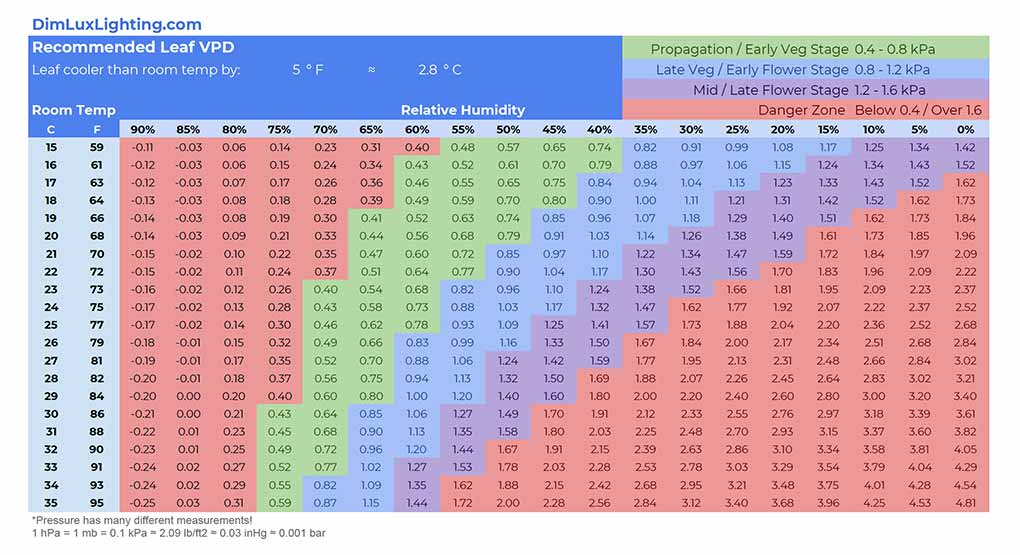- Vapor Pressure Deficit (VPD)
- The “Sweet Spot”
Vapor Pressure Deficit (VPD)
An essential part of a plant’s growth cycle is the movement of water and nutrients through the roots, up the xylem of the plant, and to the leaves where the water will escape the plant canopy through the stomata as vapor. This process is known as transpiration. The environment you create in an indoor grow space will directly affect the amount your plants transpire. Since temperature and relative humidity comprise the environment of your grow space, it is important to try and stabilize and dial in these environmental conditions as much as possible in order for cannabis growth to thrive and to prevent outbreaks of pests or pathogens. This is why growers should strive to minimize swings in these variables as much as possible. Vapor pressure deficit (VPD) impacts plant transpiration. This is because VPD refers to the difference in vapor pressure within plants and the vapor pressure of the air in the grow space. In order for optimal plant growth to be achieved, the VPD needs to be at a particular level depending on the growth phase. Since temperature and relative humidity directly affect VPD levels, you can adjust the temperature and relative humidity in a grow room to adjust the VPD level. If VPD levels are too low, pest and pathogen issues will occur, but if VPD levels are too high then growth will be limited and nutrient stresses can occur.
The “Sweet Spot”
The “sweet spot” is a certain level of VPD that allows for the best rate of transpiration which is the most beneficial for the growth of cannabis plants. In general, cannabis prefers higher levels of air temperature and relative humidity during propagation and vegetative stages of its life cycle, then prefers lower levels during the flower stage of its life cycle. Cannabis plants thrive in environments of 40-70% relative humidity and 70-80F air temperatures depending on the stage of its life cycle. If you can easily control the air temperature and relative humidity, then the last two weeks of flower should have a lower air temperature and relative humidity for an increase in flavor and flower appearance. Growers should take readings of these two variables in their grow spaces to figure out their VPD levels by comparing the two variables on a VPD chart or calculator. Certain VPD Calculators and charts will also utilize a third variable, leaf temperature, but this is not always necessary if airflow is adequate and you can still get a good estimation about the differential of vapor pressure between the plant’s leaves and the air in your grow room without knowing the leaf temperature. VPD can be measured in Kilopascals (KPa) or Pound-force Per Square Inch (PSi) it is important to note the differences because certain charts and calculators will utilize one or the other which can be confusing at first glance. The charts used for VPD will generally show the temperature along the left-hand axis and the relative humidity along the top axis. The numbers between the two variables in the chart are the VPD levels based on the relative humidity and air temperature.

A higher VPD level, will force cannabis to transpire more quickly. This is due to a drier environment. If these conditions continue and worsen then the cannabis plant’s could close their stomata as a protective mechanism to reduce moisture loss. A lower VPD level can cause pest and pathogen outbreaks if not being carefully monitored due to more moist conditions and a slower rate of transpiration. Cannabis plants should generally start with a lower VPD level, then the VPD levels should slowly increase as the plant moves throughout its life stages.
Conclusion
A relatively high VPD level (greater than 1.0KPa) means that the air can hold a large amount of water. A relative low VPD level (close to 0KPa) means that the air is near its saturation point and cannot hold more water. In order to control the rate of transpiration to obtain more vigorous growth, growers need to control the relative humidity and air temperature of their indoor grow spaces. The combination of relative humidity and air temperature can provide a measurement of the vapor pressure deficit or VPD which can give an indication of what the rate of transpiration is.
Comments powered by Talkyard.